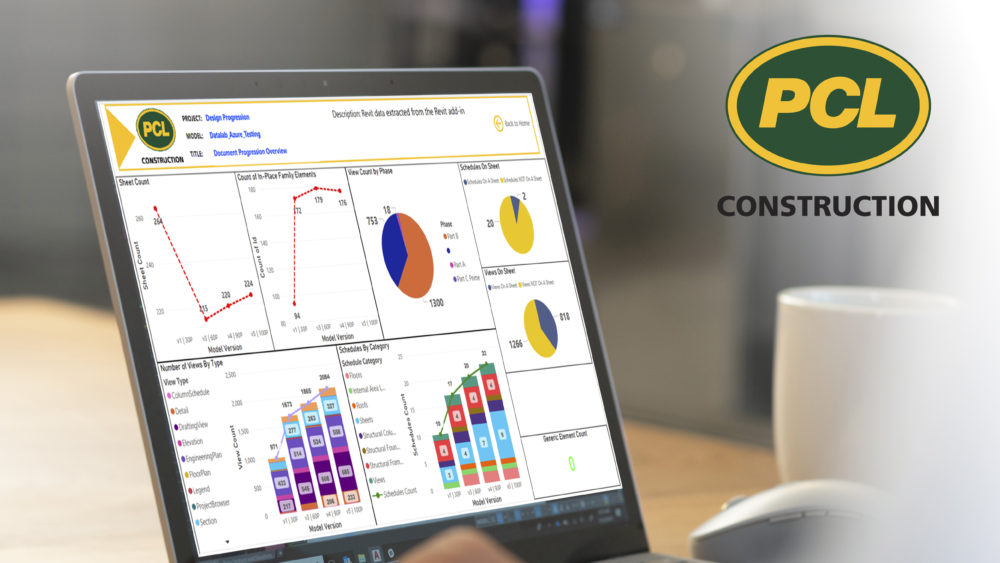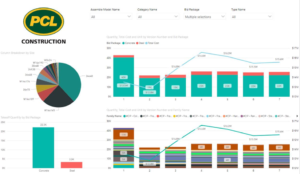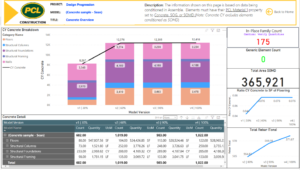Overview
PCL Construction prides itself on being an employee-owned company known for excellence, leadership, and unsurpassed value. Achieving these goals starts by empowering the individuals and the teams that can make it happen. The global network of independent construction companies works diligently towards helping PCL teams achieve business goals while taking pride in their own work on a daily basis.
As the construction industry moves towards a more digital way of working, project teams are more often made up of individuals with highly varied skillsets. PCL’s teams were no exception. Many of the preconstruction employees who were adept at interpreting 2D drawings were increasingly tasked with interpreting 3D design models. To help these team members efficiently manage preconstruction, PCL developed a data management and interpretation tool based around Autodesk® Revit®, Autodesk® Assemble®, and a Power BI Dashboard. This easy-to-use data tool helps PCL teams better interpret data and generate cost-effective designs with the most efficient use of materials.
Challenge
In PCL’s preconstruction department, many estimators and managers were highly skilled at reviewing 2D drawings and managing the pre-con process. As PCL moves towards a more digitized way of working, 3D models were becoming increasingly common. On a typical project, pre-con managers received 3D models from the design team once or twice each week.
PCL recognized that the move to 3D was essential to improve overall workflows in the company. Reviewing 2D drawings was more time consuming, and increased efficiencies would improve overall project delivery. For many projects, pre-con managers and estimators heavily relied on the VDC or design team for progress updates from the Revit environment, as they did not have Revit experience. This was an acceptable workaround, but PCL wanted a solution that could empower the pre-con team with a thorough understanding of 3D models—without becoming experts in Revit or other software solutions.
Solution
In order to develop the right solution, PCL needed to identify which model information would be most useful for the pre-con team to have readily available. A multi-disciplinary team that included estimators and VDC experts was assembled to evaluate which Key Performance Indicators (KPIs) and metrics were the most useful for measuring the health of how design is developing. For example, estimators use historic ratios to calculate anticipated quantities for things like reinforcement—such as pounds per cubic yard of concrete. This gives the team a target as well as the ability to analyze the current state of the model and drawings against that target. Having the capacity to quickly evaluate this kind of KPI not only streamlines the pre-con process, but also helps keep all parties up to speed.
The team ultimately created a road map that guided the creation of an easy-to-use data tool. Based on the agreed upon KPIs, the team selected which data was important to extract from both Assemble and Revit. This ultimately led to the creation of a Power BI dashboard that allows teams to easily view essential model data, even as updates are being made. Not all essential data was available in Assemble, and the team used an Autodesk Forge™ integration to extract essential data from Revit. Future Forge additions will further enhance the detail and clarity of the KPIs, helping improve the collaboration process during pre-construction.
“Predictability is the name of the game when it comes to construction. If we can better track the progress of design, then there will be little-to-no surprises when we receive milestone design deliverables. This dashboard solution is another means for us to drive lean principles around target value design. It’s also essential to have transparency between our design team and our precon team, and that’s a key part of what this provides.”
—Nick Kurth, VDC Manager, PCL Construction Enterprises Inc.
Success
The preconstruction teams can now leverage current design data, tracking design progression in real time. This allows PCL teams to understand if they are going to get what they need, when they need it, and how they need it from design partners. It empowers all parties to have the most current design information, allowing everyone the chance to do to their best work.
In total, PCL has built five Design Progression Dashboards for project teams to use. These dashboards have been used on two current projects that are currently in preconstruction. These dashboards are being continually evaluated and updated to improve pre-con on all future projects, and each new implementation offers a learning opportunity for PCL.
During one of these early projects, the team identified a wall that was thick, heavily reinforced, and able to support the backfill. With dashboard data readily available, the pre-con team was able to suggest an alternative design by shifting an interior wall to buttress the exterior wall, reducing the wall thickness and the structural steel needs—thereby reducing material costs during the construction phase.
As these dashboards become more efficient, pre-con managers will be further enabled to catch these opportunities for re-design and offer project owners the most cost-effective design possible.
“Our definition of success is that our teams will be able to intervene earlier in the design cycle and change the cost model on a structure, ensuring that they are delivering the best value for the owner. Historically, by the time we get completed and signed-off drawings, our ability to impact the cost of the construction is very minimal. The goal of this is to effectively monitor design progress as part of design/build team, apply value engineering concepts as changes are in progress, influence final design decisions, and improve value for the project owner.”
– Kevin Sundquist, Relationship Manager, PCL Construction Inc.
——————–
Author: By Shane Vella, Customer Success Manager and Heather Howe, Marketing Editor at Autodesk





Comments are closed.